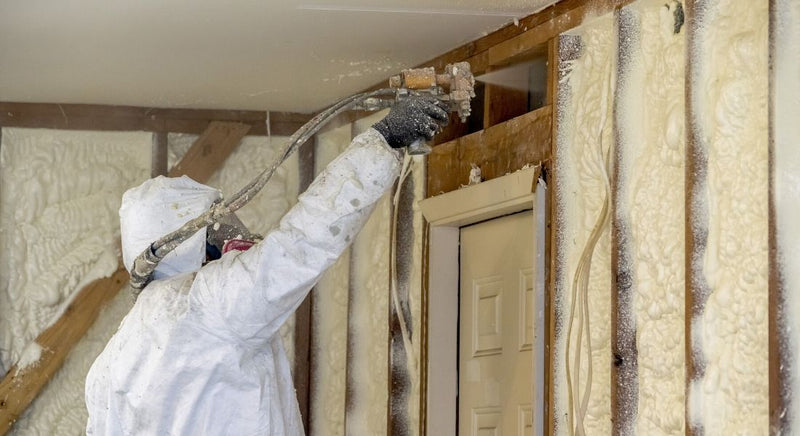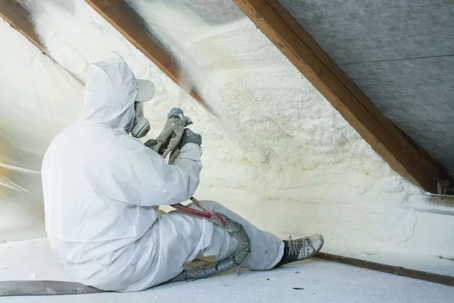Tips for Maintaining Your Spray Foam Insulation for Long-Term Performance
Tips for Maintaining Your Spray Foam Insulation for Long-Term Performance
Blog Article
Spray Foam: The Ultimate Remedy for Air Sealing and Insulation
Spray foam insulation has become a leading service for efficient air sealing and thermal insulation, supplying a distinct combination of residential properties that establish it besides traditional techniques. Its capacity to increase and fill voids makes it particularly effective in protecting against air leakage, which can substantially influence energy performance. Recognizing the full extent of its benefits, installment processes, and contrasts with various other insulation kinds is crucial for making notified decisions. As we check out these aspects, the implications for both new building and constructions and retrofits become progressively significant. What variables should affect your option?
What Is Spray Foam?
Spray foam is a functional insulation material that incorporates the concepts of air sealing and thermal resistance to enhance energy effectiveness in structures. Composed mostly of polyurethane or various other comparable substances, spray foam is applied as a fluid that expands upon contact with surface areas, creating a strong, constant layer of insulation. This distinct building allows it to fill spaces, cracks, and gaps that conventional insulation products may neglect, offering an exceptional air seal.
There are 2 main kinds of spray foam: open-cell and closed-cell. Open-cell spray foam is lighter and more flexible, supplying outstanding audio absorption and a reduced R-value per inch - Spray Foam. In comparison, closed-cell spray foam is denser, supplying a higher R-value, moisture resistance, and added architectural integrity to constructing components
The application process commonly entails specialized equipment, making sure a seamless application that sticks to various substrates, including steel, wood, and concrete. This flexibility makes spray foam appropriate for both brand-new building and constructions and retrofitting existing frameworks. Its capability to develop an airtight obstacle dramatically contributes to minimizing energy intake and improving interior air high quality, consequently making it a preferred choice among property owners and building contractors alike.
Benefits of Spray Foam Insulation
Among the most substantial advantages of spray foam insulation is its phenomenal capability to create a continual air obstacle, which properly lessens power loss. Unlike traditional insulation materials, spray foam expands to fill cracks and gaps, making certain that air leak is dramatically decreased. This characteristic not only boosts energy effectiveness yet also brings about reduce utility costs with time.
Furthermore, spray foam insulation gives premium thermal resistance, adding to a much more secure indoor atmosphere. Its high R-value per inch enables reliable insulation in constrained spaces, making it excellent for attic rooms, walls, and crawl spaces. The moisture-resistant properties of spray foam help stop mold and mildew and mold development, advertising much healthier living conditions.
Another important advantage of spray foam insulation is its sound-dampening top qualities (Spray Foam). It effectively lowers noise transmission in between rooms, creating a quieter and much more comfy home setting. The resilience of spray foam additionally stands out, as it does not sag or settle over time, keeping its efficiency throughout its life expectancy
How Spray Foam Functions
Comprehending how spray foam insulation functions is essential for valuing its efficiency in air securing and thermal resistance. Spray foam insulation contains 2 key parts: isocyanate and polyol material. When these elements are blended, they go through a chain reaction that triggers the product to increase rapidly, developing a dense foam that loads gaps, splits, and tooth cavities.
As the foam expands, it adheres to surfaces, forming an airtight seal that considerably reduces air seepage. This particular makes spray foam insulation very efficient at stopping drafts and moisture infiltration, which can bring about power loss and damages over time. Additionally, the closed-cell variant of spray foam uses superior thermal resistance because of its inflexible framework, properly reducing warm transfer.
The one-of-a-kind homes of spray foam permit it to satisfy irregular surface areas, ensuring comprehensive insurance coverage and a seamless barrier. Because of this, spray foam insulation not just enhances power efficiency but also adds to boosted interior air high quality by minimizing the accumulation of irritants and toxins. Inevitably, comprehending the mechanics behind spray foam highlights its duty as a premium choice for insulation and air securing explanation in both business and property applications.
Installment Refine Review

Before installation, the space should be sufficiently cleansed and prepped, making certain that surfaces are without dampness, debris, and dirt. This action is important because impurities can endanger attachment and overall efficiency. As soon as Discover More the location is prepared, the application involves mixing the 2 components of the spray foam, which increases upon get in touch with and loads spaces efficiently.
Educated professionals need to perform the setup, utilizing customized tools to guarantee uniform protection and optimum density. Safety precautions, including using safety equipment and ensuring proper ventilation, are essential throughout this process. After application, the foam generally cures swiftly, developing a solid obstacle that improves power efficiency.
Comparing Spray Foam to Typical Insulation
When evaluating insulation choices, spray foam insulation stands out in contrast to typical materials such as fiberglass and cellulose. Unlike fiberglass and cellulose, which can permit air infiltration, spray foam broadens upon application, filling up gaps and holes to produce a closed seal.
In addition, spray foam supplies a greater R-value per inch than conventional insulation kinds, using even more effective thermal resistance in a thinner account. This characteristic is especially beneficial precede with restricted tooth cavity deepness. Additionally, spray foam is immune to dampness and mold and mildew development, which can be a substantial concern with cellulose and fiberglass, specifically in humid settings.
Nonetheless, spray foam insulation commonly brings a greater ahead of time cost than its standard equivalents. House owners must evaluate this first investment against long-term energy financial savings and performance advantages. Ultimately, while both insulation kinds serve their purpose, spray foam emerges as a much more sophisticated service for modern insulation requirements, especially in terms of air sealing and thermal effectiveness.

Conclusion
In summary, spray foam insulation stands for a highly efficient option for attaining ideal air sealing and thermal resistance. Its special residential or commercial properties, including moisture resistance and audio dampening, make it ideal for various applications in both new building and constructions and retrofitting projects (Spray Foam). The preliminary prices may be higher contrasted to conventional insulation products, the lasting benefits, such as considerable power savings and improved indoor air quality, warrant the investment and highlight its worth in modern-day structure methods.
Spray foam insulation has emerged as a leading service for reliable air sealing and thermal insulation, using an unique mix of homes that set it apart from standard approaches.Spray foam is a flexible insulation product that incorporates the concepts of air sealing and thermal resistance to improve power effectiveness in buildings.When examining insulation options, spray foam insulation try this stands out in comparison to conventional products such as fiberglass and cellulose. Eventually, while both insulation types serve their purpose, spray foam emerges as a more advanced remedy for contemporary insulation needs, specifically in terms of air securing and thermal efficiency.
In summary, spray foam insulation represents a highly efficient solution for attaining ideal air sealing and thermal resistance.
Report this page